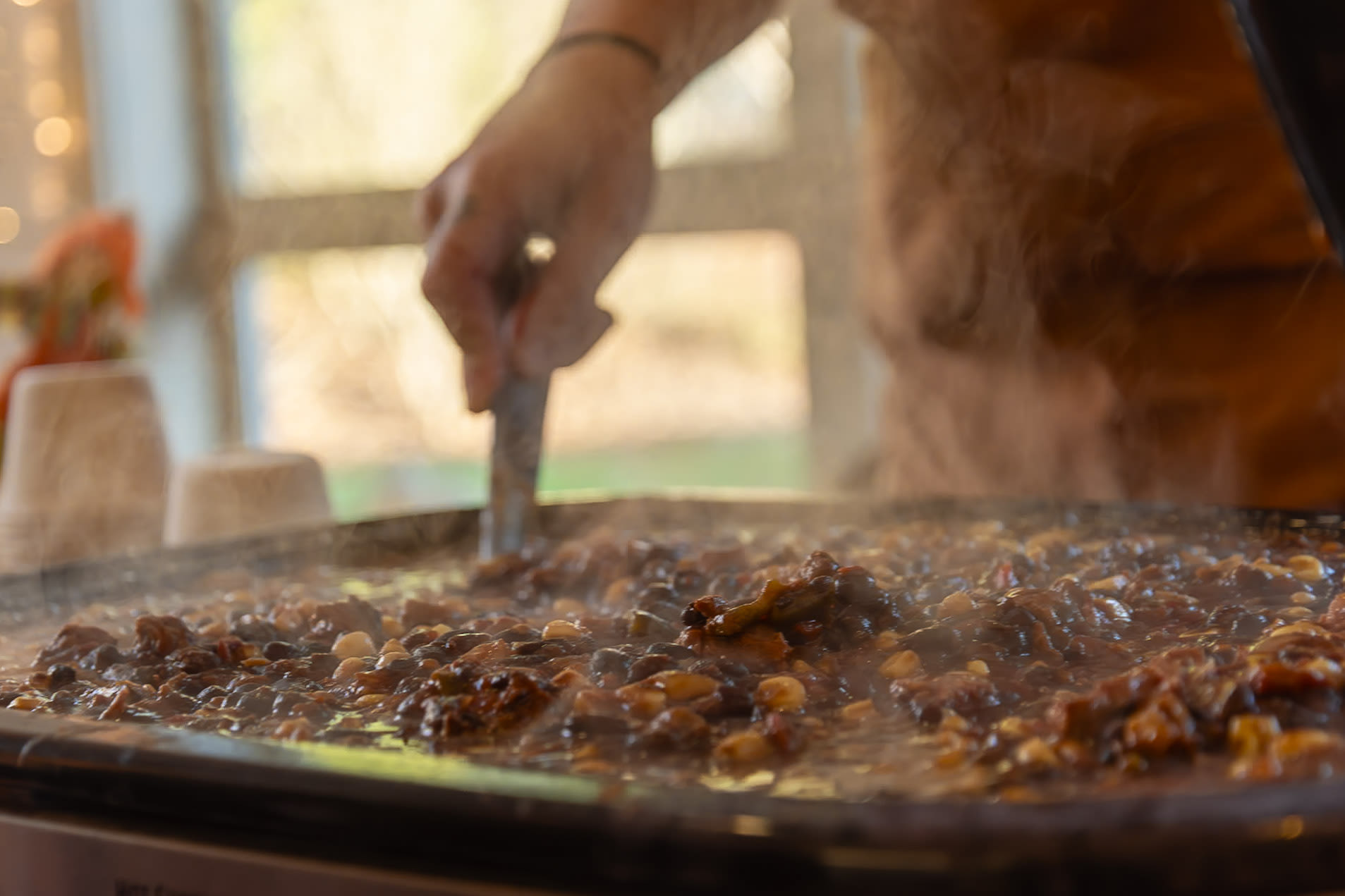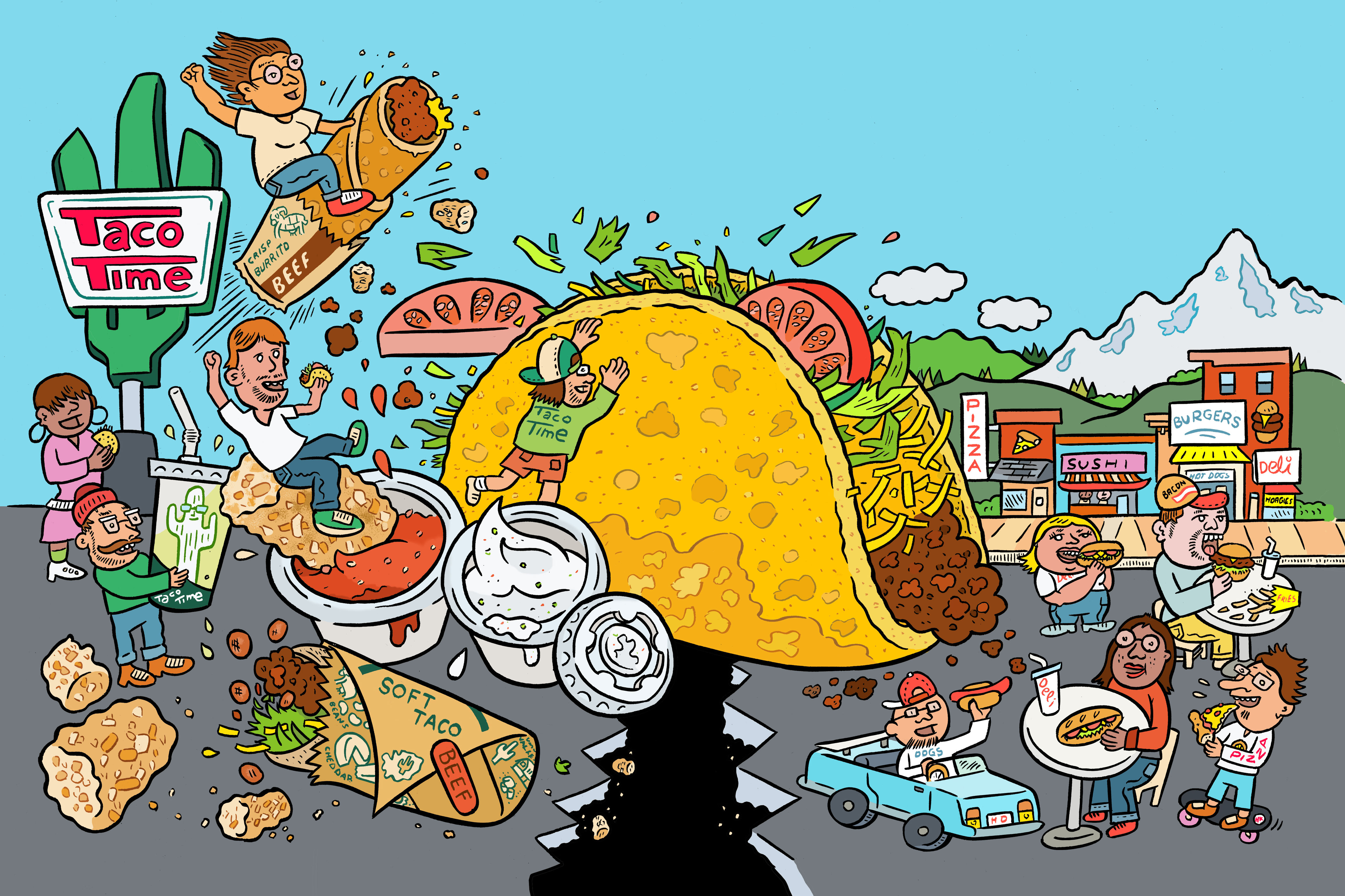
Washington’s Great Taco Time Divide
It wasn’t supposed to be a podcast about Taco Time.
James Lim and Amy Faulkner launched Dear Elite Reviewer to discuss how crowdsourced reviews, like Yelp, can affect restaurants and small businesses. Their accidental benchmark revealed itself during episode six, a conversation with Musang chef and owner Melissa Miranda. At one point, during a discussion of whether one restaurant can truly appeal to everybody, Miranda invokes the name of one of the Northwest’s most venerable fast food chains.
Upon hearing the words “Taco Time,” the podcast cohosts explode with opposing reactions. Faulkner, originally a New Yorker, utters the words “total garbage.” Lim, who grew up in Bothell, erupts with the sort of cheers usually reserved for overtime wins. Miranda’s not a chef you picture frequenting restaurants that have a drive-thru window and a menu of combo meals. Her face peers out at you from a recent issue of Food and Wine. Her dad catches the squid she uses in her seasonal pancit.
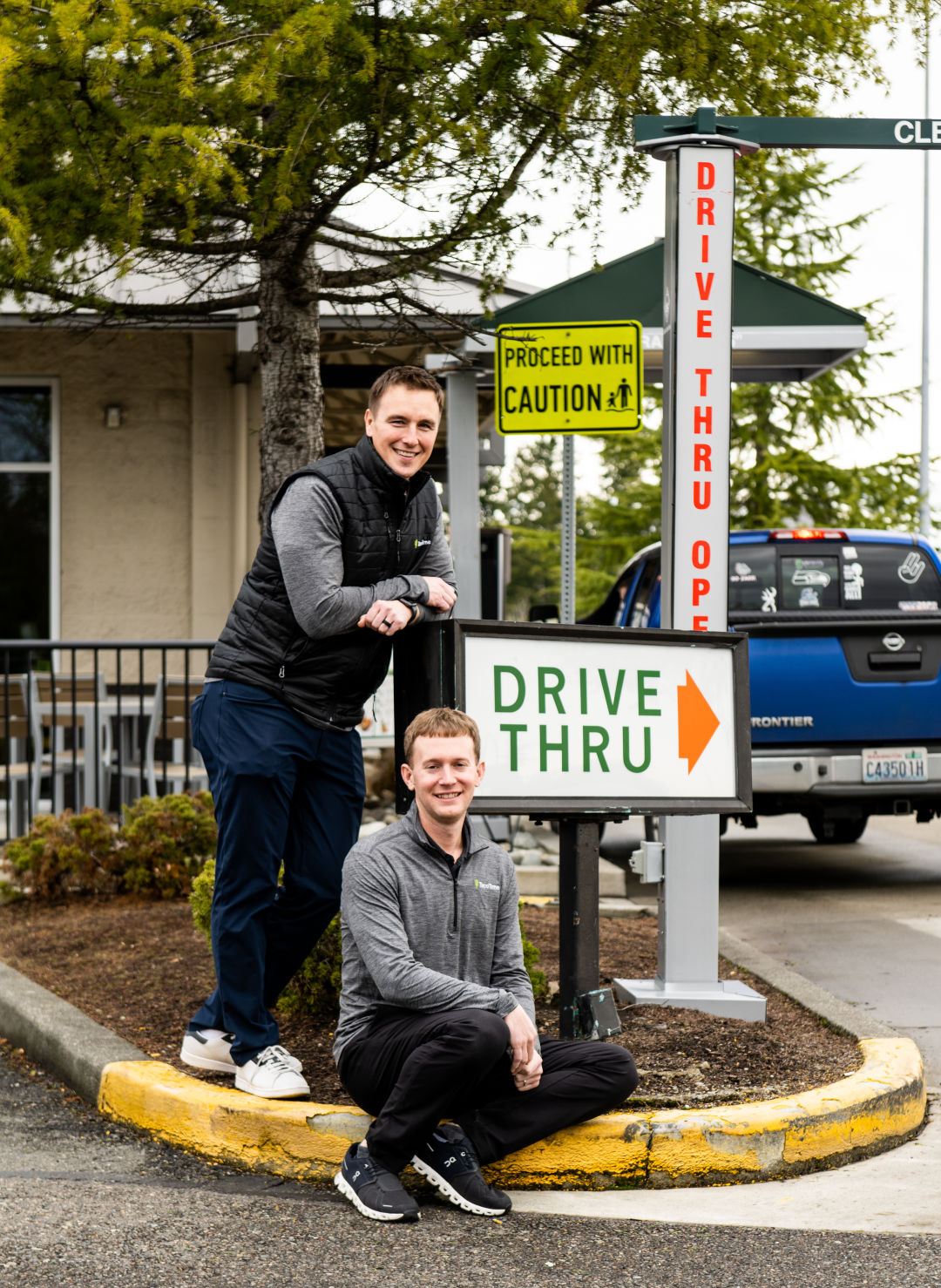
Copresidents and cousins Robby (standing) and Chris Tonkin.
Image: Chona Kasinger
The (mostly) joking contention around Taco Time between Dear Elite Reviewer’s cohosts became a theme. Then it became a litmus test. The podcasters asked each subsequent guest for their opinion on the restaurant.
A clear pattern emerged. Anyone who grew up in Seattle gushed about Taco Time’s hot sauce and oversize soft tacos. Robin Wehl Martin of Hello Robin cookie bakery adores the nugget-shaped ice cubes—“it’s so nice to crunch.” The non-natives, Lim remembers today, didn’t share that enthusiasm. “The best we get from out-of-towners is… ‘I get it. But I don’t agree.’”

Taco Time cooks its chicken in relatively modest five-pound batches throughout the day.
Image: Chona Kasinger
The stylized cactus logo of Taco Time Northwest stands, green arms upstretched, at 77 locations up and down Western Washington. If you grew up here, chances are you’d defend its curious menu of tacos with ranch dressing and slender fried burritos to the death. Devotees look at the enormous menu not with overwhelm, but with conviction that they have, over the years, honed their ideal custom order. This meal could include a soft taco so gargantuan it might as well be a burrito. Or the “crisp burrito” that resembles a deep-fried cigar. Anyone with even the slightest knowledge of Mexican food will point out it’s really a pumped-up flauta. Hardly any customer exits the drive-thru without a paper bag of well-seasoned tater tots most people still call by their old, culturally dubious name, Mexi-Fries.
I arrived in Seattle 13 years ago, and even as a food writer, the chain never hit my radar as anything noteworthy. Sure, I drove past the gaudy mirrored location in Wallingford. Even ate at the Interbay one with a friend who’s a diehard fan. But Taco Time does little to stand out to folks who aren’t already familiar. For newcomers, these restaurants fade into a landscape crowded with other drive-thrus. Not to mention Del Tacos, Blue Water Taco Grills, and the ultimate in soulless Mexican food, Taco Bell. A white guy named Glen Bell founded that chain in a Los Angeles suburb in 1962—the same year a white guy named Frank Tonkin Sr. debuted the first Taco Time Northwest here in White Center. According to family legend, customers didn’t know how to pronounce their signature menu item, ordering them as “tay-cos.”
Months after Dear Elite’s first season, Lim recalls his own foundational Taco Time experiences—how his dad would take him to the Canyon Park location after soccer games for a crisp burrito or two. Lim is a longtime coffee professional who owns Watson’s Counter in Ballard. He has a barista’s precise palate and prefers Taco Time over southern California’s iconic In-N-Out—the hottest of takes when talking regional fast food. But his passion comes with caveats. “It’s obviously a complete bastardization of Mexican food,” he says. Taco Time’s menu constitutes “this weird Mexican, Tex-Mex, Pacific Northwest thing.”
In a world of golden arches and Taco Bell–KFC hybrids, longtime local fast food chains like Burgerville to our south, Wisconsin-based Culver’s, or Texas’s titanic Whataburger remain beacons, reflecting and reinforcing our regional identities. Here in Seattle, Dick’s Drive-In might be our most visible fast food touchstone. This burger chain, with its neon signage, tracks with the vision of Seattle we want the rest of the country to see: employee benefits, hand-cut fries, 1am stops after a night of Capitol Hill bars. The stuff of Sir Mix-a-Lot lyrics and Macklemore videos. But Taco Time Northwest represents Seattle as we truly are: progressive and earnest, grappling with our whitewashed past. Not seeking attention, just over here quietly making our own hot sauce from scratch.
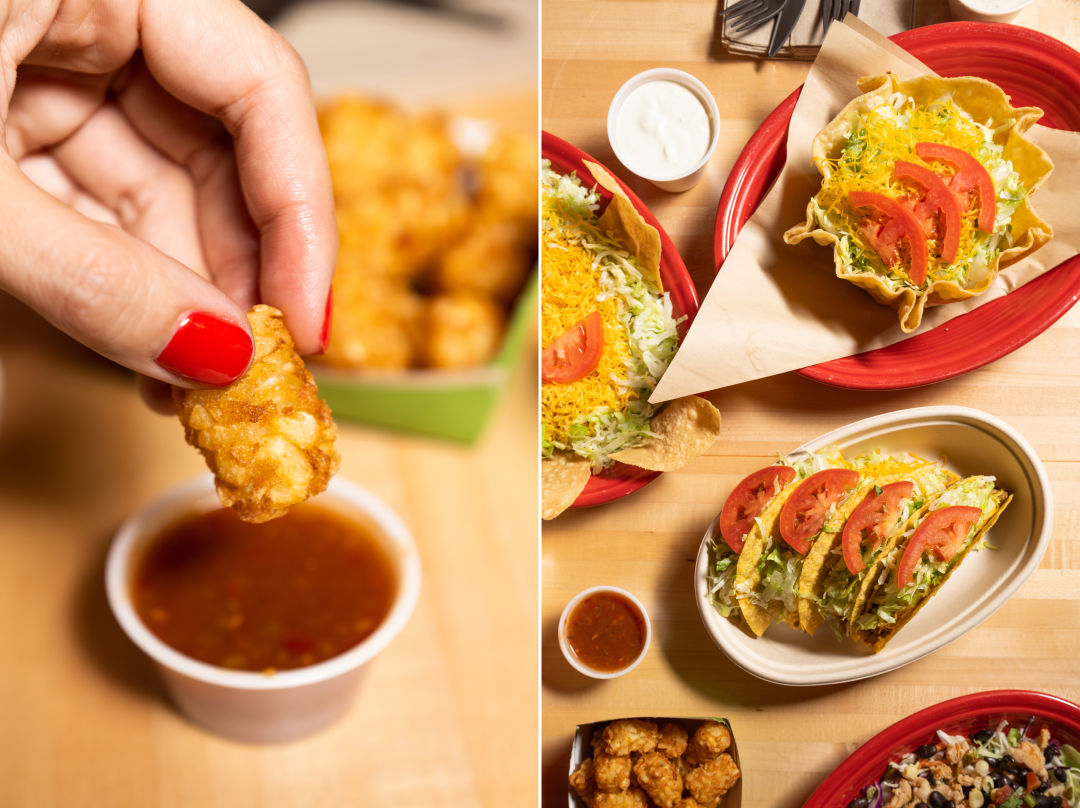
Hours of prep yields fast food with a fan base.
Image: Chona Kasinger
When Kristine Hepburn works the morning shift at Taco Time’s Rose Hill location, her favorite prep task involves hand-rolling crisp burritos. “Sometimes you kind of race yourself,” she says, to see if she can fill an entire hotel pan with tidy cylinders in 10 minutes or less. The store in suburban Kirkland opens at 10am; the morning crew flips on the lights at 7. Black beans and dried pintos, grown in Washington, go on the stove first in enormous soup pots. Each 25-pound batch takes roughly three hours to cook. The person on fry routine has the most daunting task: prepping hundreds of crispy shells and bowls for taco salads, plus the pumpkin seeds that go into salads and veggie burritos. Not even the chips arrive premade; employees fry cut-up tortillas each day.
Hepburn’s worked here a lot lately, helping to train a new hire. She’s been with the company since 1985, when she took a gig as a crew member at the old Rainier Avenue location. “I told people, ‘This is just my part-time job while I go to college,’” she recalls. Nearly four decades later, she’s a district manager.
By 9:30, the staff is sautéing the first of the day's many batches of chicken. The morning’s punch list includes dicing tomatoes for the pico de gallo, mixing salsa (both corn and mild red), and making the day’s hot sauce in a commercial steam kettle. Taco Time employees each spend about three hours in the morning doing the sort of actual cooking you don’t expect in restaurants like this. If people hand-shred heads of lettuce and 40-pound blocks of aged cheddar from Sunnyside-based Darigold, does it even qualify as fast food?
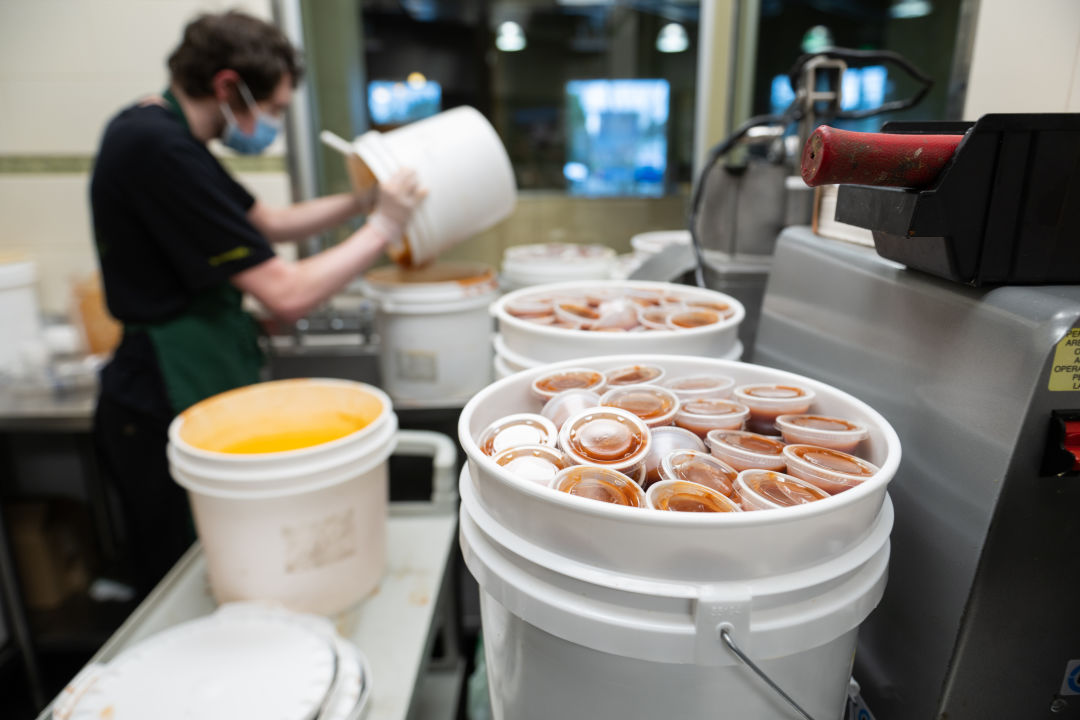
Image: Chona Kasinger
The company’s biggest labor expense, copresident Chris Tonkin says, is the time an actual human spends affixing caps to more than a million tiny plastic containers of that hot sauce each month. “For something we give away for free.” The morning schedule came as a shock to a recent hire from Domino’s Pizza who put in maybe 30 minutes of prep before the store opened. At his old job, he told Tonkin, “We just open the bags and put stuff out.”
Among the many idiosyncrasies of Taco Time: It has two presidents. Chris and his cousin, Robby Tonkin, are 37 and 43 years old, the fourth generation of their family to run the company their great-grandfather started six decades ago. The familial transfer was gradual and understated, says Robby. Some of the company’s key employees have been around since he was eight years old: “This is no Game of Thrones.”
Nor is it Succession. Robby’s voice always sounds like he’s smiling; Chris has a streak of mordant humor that presents itself eventually. They both use the word “heck” in a way that doesn’t give you the impression they’d really rather say “hell.” As copresidents, they’ve introduced an ordering app and bought back some franchised locations to keep restaurant operations more directly under their oversight. You could easily mistake Taco Time’s presidents for two earnest members of Seattle’s badged tech masses if it weren’t for their lack of desire to optimize or disrupt things, at least where food is involved.
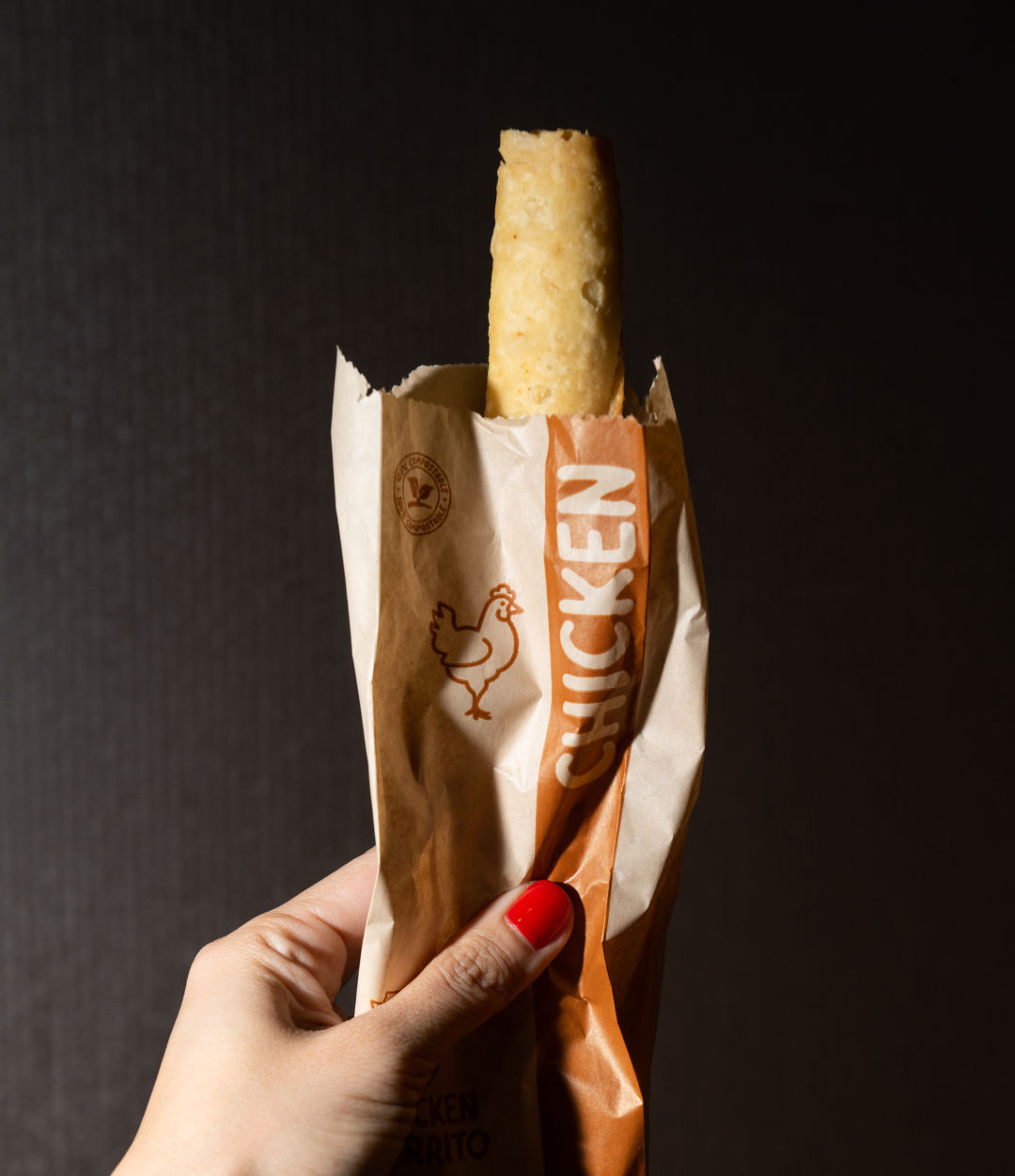
Image: Chona Kasinger
“It’s a very humble family, which translates into humble marketing,” says Taco Time marketing director Gretchen Weidemann. She’s been with the company for 31 years; her first boss was her current bosses’ great-grandfather. “They don’t drive flashy cars.”
On opening day in 1962, Taco Time served seven items. The hard-shell taco you still see on the menu cost 34 cents. Today the restaurant sells more than 90 items, from enchilada platters to combo meals to coconut shrimp soft tacos. I showed it to José R. Ralat, whose official job title is taco editor at Texas Monthly magazine. His book, American Tacos, delves into regional styles from Memphis to California. On the subject of tacos, the man is both bard and scholar.
I expected him to eviscerate Taco Time’s menu. Ralat did get a kick out of the flauta-size crisp burritos. “The Baja taco line boggles my mind,” he says. “Flour tortillas aren’t really a thing in Baja.” Neither is ground beef. “And ranch dressing? What the heck is that?!”
But the menu tracks with certain similarities he’s seen in our quadrant of the country. Like the affinity for flour tortillas rather than corn. The need to involve tater tots—themselves a Northwest invention. Or variations on the crustos, Taco Time’s dessert of fried tortilla strips dusted in cinnamon and sugar. “It’s almost like all these little chains got together and decided, ‘This is what Northwest fast food Mexican is going to look like,’” says Ralat. He draws an existential line to Taco John’s, a massive chain that began in Wyoming and now owns the trademark for the phrase “Taco Tuesday.”
In Ralat’s travels, he’s witnessed the taco’s inclusivity and its capacity to reflect the truths of its surroundings. In Washington’s case, that truth is the tacos that entered our midcentury mainstream had little to do with their culture of origin. However.
“I don’t believe in white people tacos,” he says. “I don’t think they exist.” Even Taco Bell, he points out, employs and serves people across all demographics. “Is it really white people food if everyone’s eating it?”
When Randy Coté and his husband, Patrick, touched down at Sea-Tac, bleary-eyed and scrungy from a nine-hour flight from Tokyo, they spoke not a single word about their first meal home after a week and a half in Japan. They didn’t need to. Once the couple reclaimed their checked luggage, Patrick turned to Coté and simply said, “I’ll have the usual.”
The usual, of course, was Taco Time. When he’s stateside, Coté eats chicken soft tacos and crisp burritos just about every week. His level of fandom once earned him a spot in one of the restaurant’s ad campaigns. In July 2018 he embarked on a project—which he calls simply “the quest”—to visit all 77 Taco Time Northwest locations.
The journey began when Taco Time introduced an app, and with it, the ability to see your purchase history. Coté had already logged about 10 locations, just going about his life. Today he keeps a meticulous spreadsheet that records details of his official visits—69 and counting. The rules: He must go inside to order and, ideally, eat in the dining room. Drive-thrus don’t count.
Coté is 35; he ate Taco Time occasionally as a kid in Lynnwood. But he really started communing with the brand in his late 20s, when he worked in the Seattle Storm’s ticket sales department—“lot of Taco Time fanatics in that office,” he says of the WNBA team. The restaurant’s nearby Interbay location was a frequent lunch spot. At work, he has a reputation. “If someone went to Taco Time and didn’t tell me, they knew that I’d be really bummed that they’d order the wrong things.”
During a one-week staycation in 2019, Coté entered 13 new visits into his official spreadsheet. He’s been known to visit three, even four locations in one day if geography permits. But arbitrarily pointing his gray Nissan Leaf toward Bellingham or Gig Harbor isn’t the point.
The “notes” field of Coté’s spreadsheet details post-hike tacos with a friend at the Factoria location, or meals grabbed before and after hockey practice in the suburbs. In aggregate, his Taco Time visits form a picture of a life—one with an enviable serving of loved ones, hobbies, and time outdoors. It’s hard to not get misty eyed over a retroactive entry for December 30, 2015: “Reintroduced my future husband to Taco Time.”
Coté’s dispatches along various points of “the quest” ultimately landed him a cohost gig on another local podcast. Unlike James Lim’s Dear Elite Reviewer, this one was absolutely intended to focus on Taco Time Northwest.
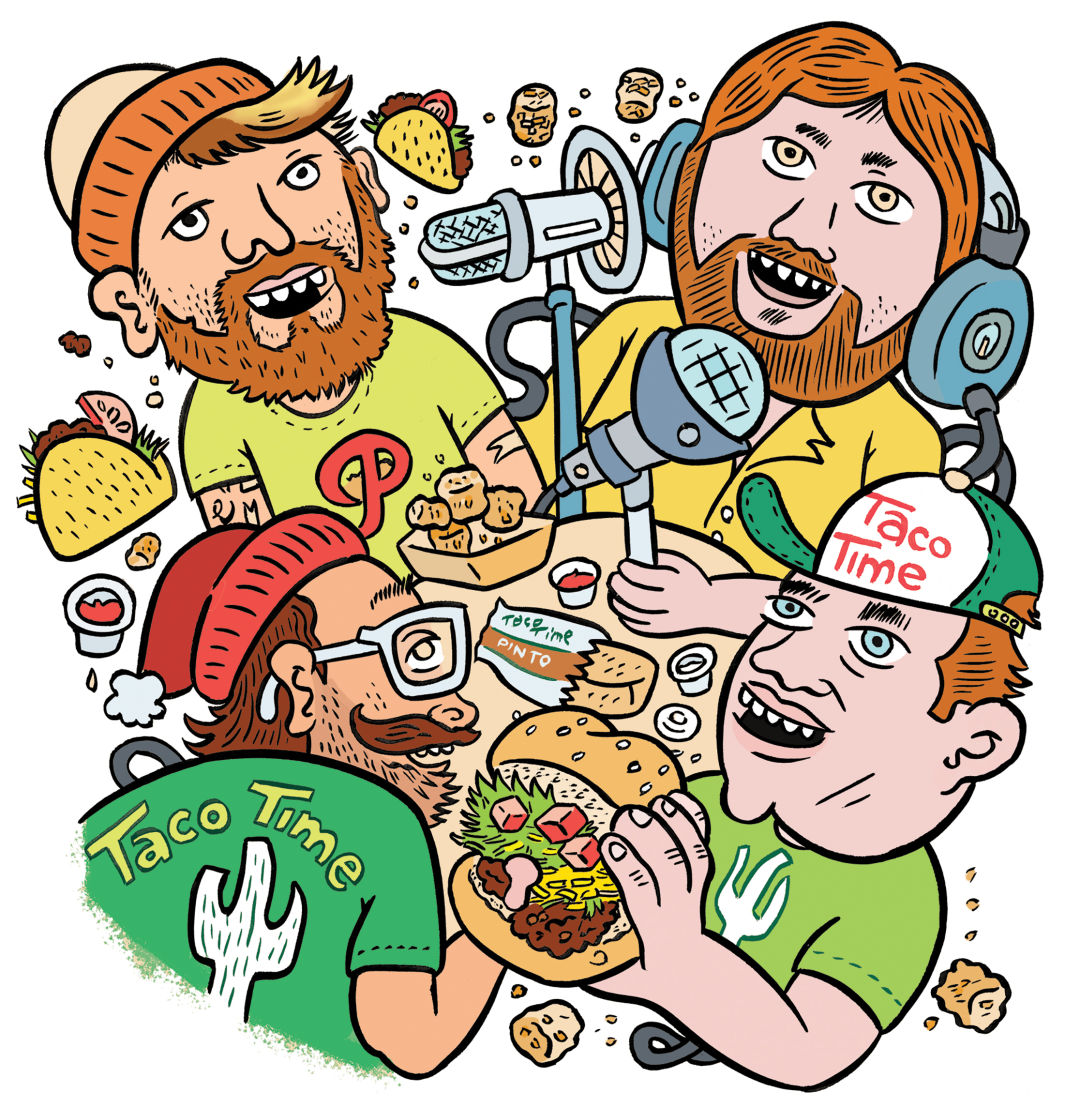
Image: Hawk Krall
One recent Saturday, the four hosts of Talkin’ Taco Time gathered at Kevin Pelton’s house in West Seattle to record an episode. Local logos represented on various hats, hoodies, and quarter-zips: University of Washington, Pagliacci Pizza, Rainier Beer, and, on Coté’s T-shirt, the official Talkin’ Taco Time logo. Before recording, they sat in Pelton’s minimalist living room, eating doughnuts and razzing each other the way people with a long history can.
By day, Pelton writes about basketball for ESPN. He and his brother, Tristan Carosino, grew up in the south suburbs, near Sea-Tac. A decade ago, the siblings turned their commute-time phone calls about sports into a proper pod, The Fabulous Peltoncast. Conversation often drifted to food. Debating the city's best fried chicken or pizza or tacos also helped fill the quiet summer season, when the Mariners didn’t have much to report.
Talkin’ Taco Time began in 2018 as a semi-joking spinoff. Local music producer Jake One came on the first episode to talk about his high school job at the Bothell location, where he quit only after making 20 soft chicken burritos to accompany him out the door. Pelton and Carosino brought in their childhood friend, Chris Smith, whose combined six years as a Taco Time employee somehow left him even more enthused about the company than when he started.
While the brothers certainly enjoy a good soft taco or crisp burrito, their podcast began not as a paean of superfandom, says Carosino, but as a gateway topic. “It opened up a new opportunity to talk to people from Seattle.” He manages local and national bands, and Taco Time promised an unexpected way to engage with athletes or musicians they wanted to have on as guests. These sorts of notables get tired of fielding the same interview questions—you can only come up with so many new ways to discuss your first album or upcoming season.
Pelton approaches Taco Time subject matter with the hoarse enthusiasm of a guy accustomed to color commentary. Carosino comes in with the big-picture takes and pulls in local creatives to share stories about their Taco Time obsession. Smith maintains a deadpan delivery as he drops knowledge he gleaned in Taco Time kitchens, like a description of the jackhammer-like device used to mix the ranch. Today he handles heavy equipment rentals. If the hosts’ jobs—in sports, in music, in construction—feel like a specifically Seattle edition of the Village People, well…Coté is the chief marketing officer for the Space Needle.
The trope of old Seattle versus new Seattle is reductive and dumb. But newcomers who have arrived in record numbers undeniably experience the city on a different frequency than the people who grew up watching hydroplane races at Seafair, staying up late to watch Almost Live, and hearing Taco Time jingles on TV commercials.
In the mid- to late-1990s of their childhood, “Seattle was a much smaller place,” Pelton remembers. Before the rise of Amazon and Starbucks, after the heyday of Boeing, the city seized upon sports for much of its identity. Taco Time’s logo appeared on the back of Seattle Sonics trading cards and on commemorative cups, next to a caricature of Ken Griffey Jr. with his arm around the Mariner Moose. Trips through the Taco Time drive-thru formed a common thread so ubiquitous and obvious, nobody really thought about it.
These formative years also happened to be the era when Seattle got cool. Coté remembers watching his quiet city suddenly explode into the nation’s zeitgeist. It was the era of Frasier and Nirvana, even Sir Mix-a-Lot. MTV filmed a season of The Real World here; the Mariners and the Sonics were both contenders. Coté remembers seeing Bob Costas come to the brand-new Key Arena to broadcast the NBA Finals. His hometown had long been a sleepy city in the country’s remote corner. All of a sudden, he says, “people noticed Seattle.” Nostalgia for this era runs deep.
It’s not lost on Coté that Taco Time debuted the same year as his employer, the Space Needle. “To me it’s all part of this weird fabric. This place has so many quirky unique things, and we’re in on the joke.”
One of those quirks includes the confusion that reigns when Taco Time fans leave home.
On a rainy afternoon in Beaverton, Oregon, a Taco Time sign beckons from a suburban intersection. There it is, that familiar name, a cactus that resembles a forerunner of the shrug emoji. But something’s not quite right. The cactus is louder, gaudier than the Tonkin family’s totem. Technically the sign reads "TacoTime," all one word. Inside, on a much smaller menu, I find the familiar tacos, those idiosyncratic crisp burritos, even Mexi-Fries, which inexplicably come plain or stuffed. But also unfamiliar burritos filled with “sweet and savory” carnitas, even chicken strips.
I squint at the menu. “What’s inside the stuffed Mexi-Fries?” I ask the woman in the blue shirt and apron who’s taking my order.
“Like, a cream cheese, and a little bit of jalapeno,” she offers. “They’re pretty good.” It feels like the first time I realized Kit Kats in Japan come in a whole spectrum of different flavors. I haven’t left the country this time, but I have crossed a tremendous demarcation in the universe of Taco Time.
Every hero is better with a villain. For people who grew up with Taco Time Northwest, that nemesis is an enormous multinational restaurant chain with a strikingly similar name and an even shinier cactus logo.
Any time you visit a Taco Time outside Western Washington (with one exception in the fine city of Wenatchee), you’re visiting an entirely different company, all-one-word TacoTime. It's owned by parent company Taco Time International. The menu is like a dialect of Taco Time Northwest. Antipathy for Taco Time International is a central tenet of the Talkin’ Taco Time podcast. One very special episode recounted Pelton's visit to a location across the state in Yakima. He systematically trashed this bizarro-verse menu, which presumably does not benefit from fresh ingredients and three hours of kitchen prep.
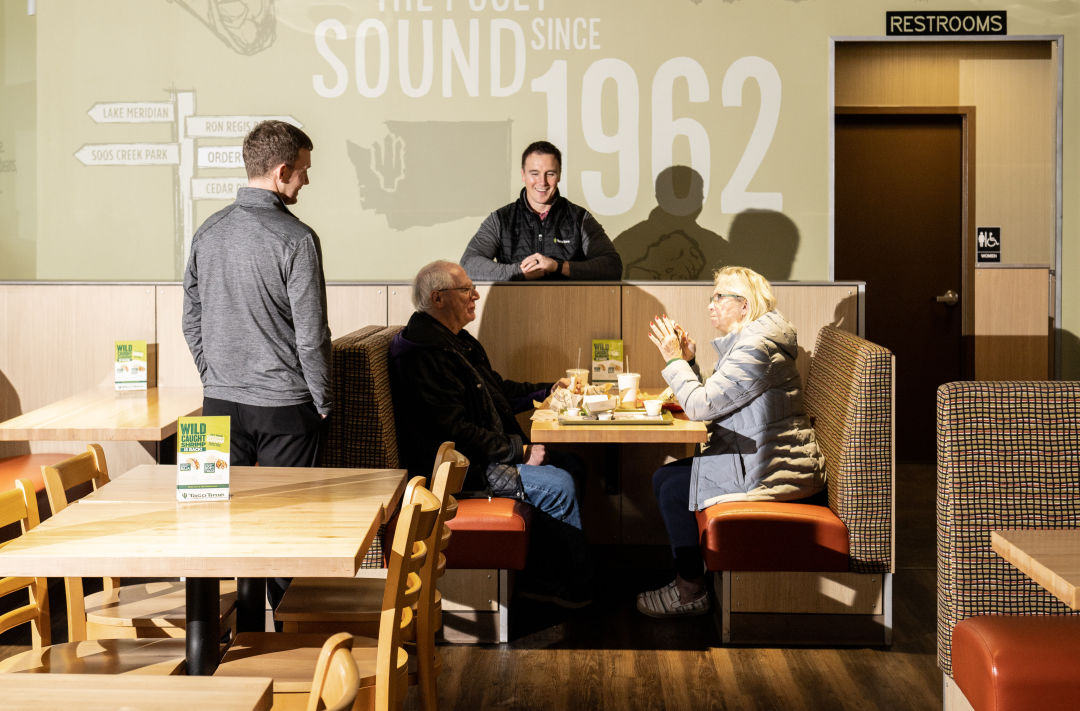
Image: Chona Kasinger
As fast food goes, it’s perfectly fine, a step or two above Taco Bell, even. But even the twinned menu items, like the crisp taco, have that sort of chemically induced ghost flavor that defines most drive-thru meals. The staff is warm and friendly, but I’m still not over the menu item that consists of a massive tostada with a large flour tortilla wrapped around it, pleated like an oversize flying saucer dumpling. Customers come to Taco Time Northwest locations with coupons for burritos that do not exist in this reality. Or they hit up the tacotime.com website to place an order when they really wanted the menu over at tacotimenw.com.
“It’s frustrating,” says Robby Tonkin of his company’s exceedingly corporate doppelganger. “You go to a TacoTime in Oregon—it’s totally not related to us, and it’s awful. It’s very different from what we’re doing.”
The distinctions are stark, but the resemblance is no accident.
In 1960, Ron Fraedrick opened the very first Taco Time in Eugene, Oregon. Frank Tonkin Sr., paterfamilias of our hometown Taco Time, went into business with him.
Things went smoothly for a while, but “at the core, our great-grandfather was a restaurant operator,” says Chris Tonkin. Fraedrick, meanwhile, “was just franchising to anyone.” That didn’t sit well with Frank, a guy who genuinely enjoyed the practice of hospitality and food service. He had already run Tonkin’s Cafe and a burger stand called Bif’s by the time he got into the tay-co business.
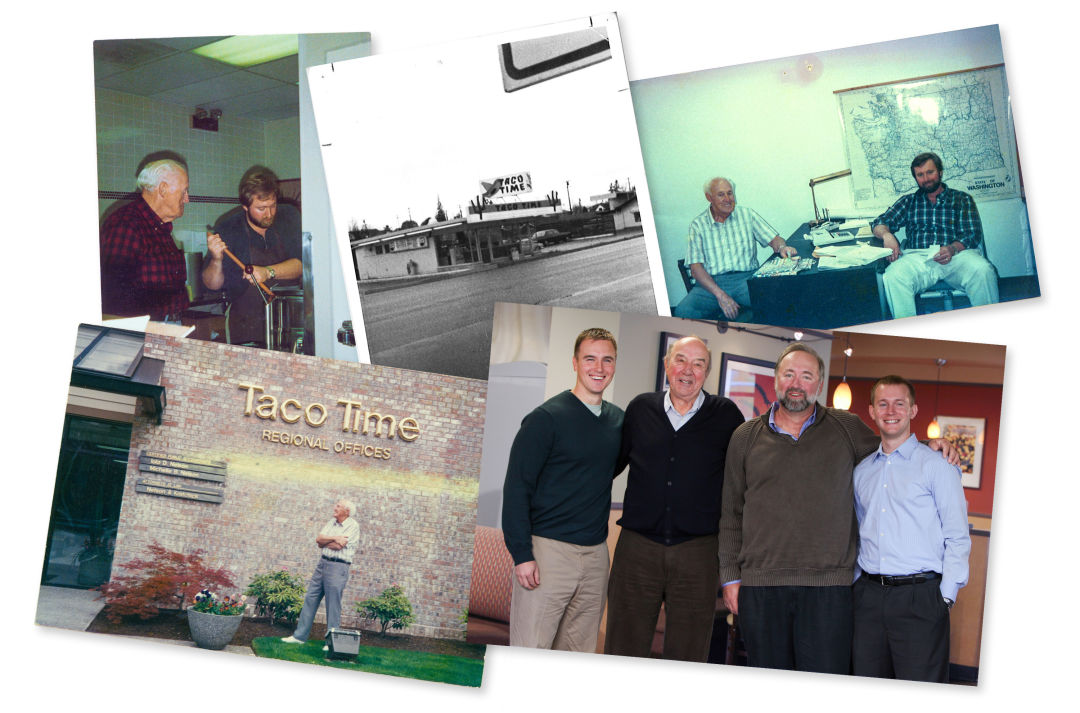
Four generations of Tonkins (Frank Sr. and grandson Matt; Robby, Jim, Matt, and Chris) and the White Center location.
Image: Courtesy Taco Time Northwest
In 1979, Frank Tonkin struck a deal with Ron Fraedrick. He’d form his own company and claim the western half of Washington as his own territory. From then on, Tonkin ran Taco Time Northwest; Fraedrick continued to build what’s now known as Taco Time International. Today the latter has more than 300 franchises, from Canada to Kuwait. It’s owned by a Scottsdale-based holding company, part of a portfolio that includes Cold Stone Creamery, Pinkberry frozen yogurt, and the sub sandwich chain Blimpie.
Weirdly, nobody considered changing their names to avoid confusion. “When they split, the internet wasn’t around,” Chris Tonkin points out. Clearly this sort of arrangement would never fly today, but it does give us the fast food version of studying twins who were separated at birth, then nurtured on two very different sets of commercial values.
One night, Randy Coté was scrolling Instagram and came upon a Taco Time sponsored post that surely had to be an error. The ad mentioned something called tater fries.
Tater fries? He stared in disbelief, then consulted Taco Time’s ordering app to find this unannounced rebrand was, indeed, real. Since the restaurant's early days, Taco Time’s perfectly seasoned, top-selling tater tots have been known as Mexi-Fries.
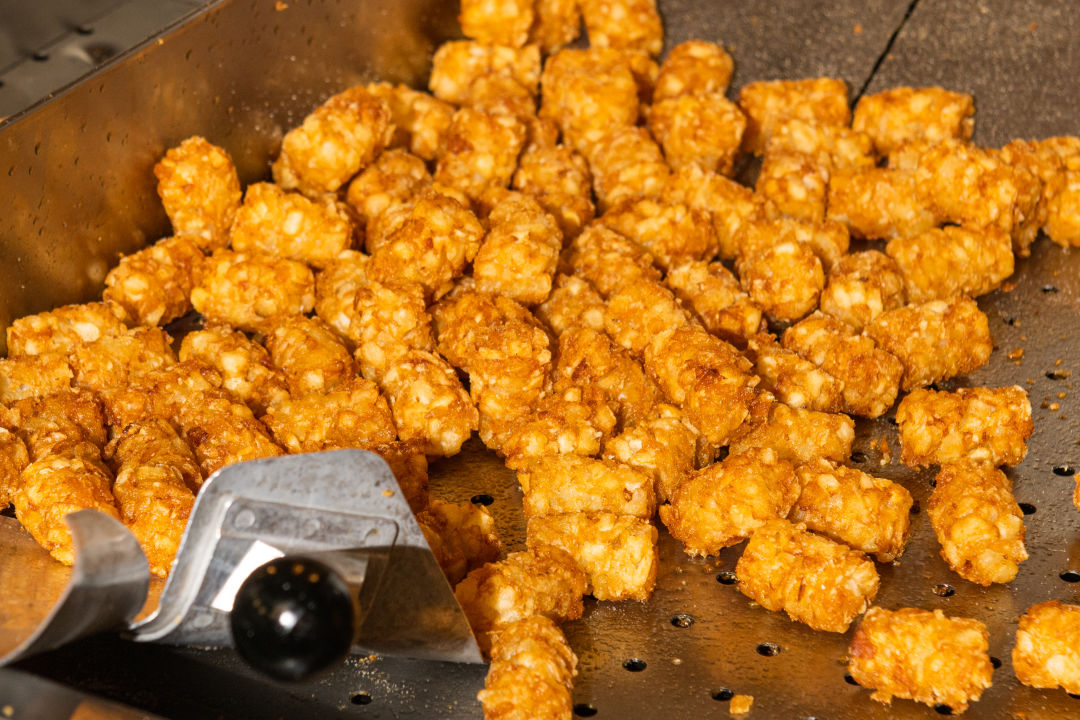
Image: Chona Kasinger
The hosts of Talkin’ Taco Time convened an emergency pod to discuss this seismic name change. They unpacked the choice from every angle. It was November 2020, the end of a year when plenty of companies examined their blind spots and ways to be anti-racist. The consensus: Ditching “Mexi-” as a diminutive prefix was overdue. Still, emotions ran high.
“The name is inexcusable,” says Coté of the new moniker. Plus, complained Chris Smith, “the word ‘tater’ is just stupid.” (Not to mention redundant when you pair it with the word “fries.”)
Subbing in such a bland term felt especially egregious for the menu item that regularly lands in the final four of the podcast’s annual Taco Time menu bracket. It also derails part of the secret-handshake appeal that inspired a podcast about Taco Time in the first place.
The kookiness of having an item called “Mexi-Fries” that are, in fact, tater tots, is part of the very particular culture of this restaurant. “It’s a tell if you call them tater tots,” Pelton offers. A tell that you aren’t from around here. Carosino frames it in sweeping terms: “That’s part of the history, that’s what’s in our blood…generations growing up with Mexi-Fries, being in on this conversation.”
The name change, enacted over Halloween weekend, received little attention outside of the podcast and the occasional subsequent Reddit comment. The Tonkins are characteristically understated about the decision. To call some big press conference “is the opposite of how we operate,” says Chris Tonkin. “We didn’t come up with the name.” Eventually, “it didn’t feel right. So we changed it.” Everything can be so political, says Robby. “We’d rather not have barriers to our food. The key thing is people still order them.” Taco Time’s reluctance to talk about itself could be just as responsible for locals’ obsession as it is for newcomers’ puzzlement.
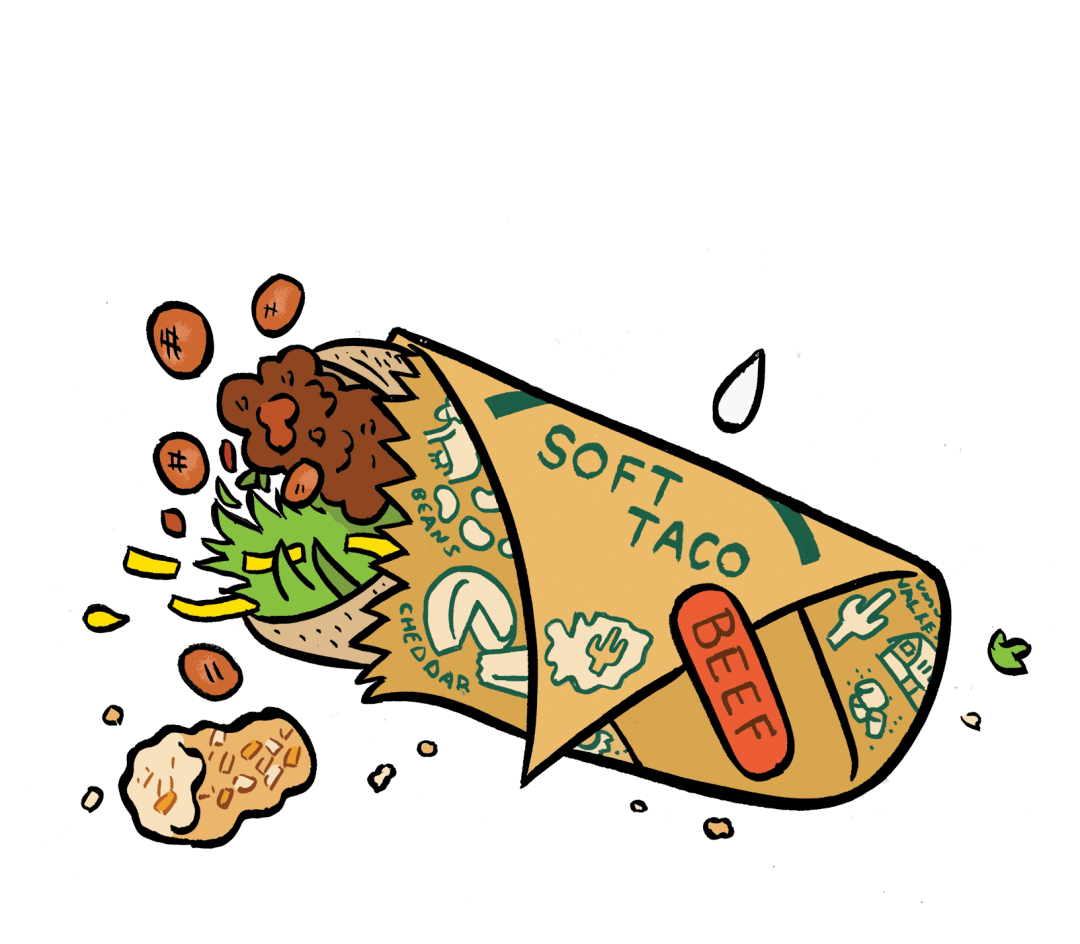
Back on the emergency pod, Pelton comforts his compatriots. For most of their adult lives, their city’s been changing with the swiftness of tortillas dropped into a fryer to become chips. It’s easy to worry Taco Time’s unique attributes might disappear. That a fixture of a distinctly Seattle upbringing might be replaced with an experience as generic as the new construction that notches our current skyline. “The soft tacos are still actually burritos,” Pelton offers by way of consolation. “That’s not gonna change.”


